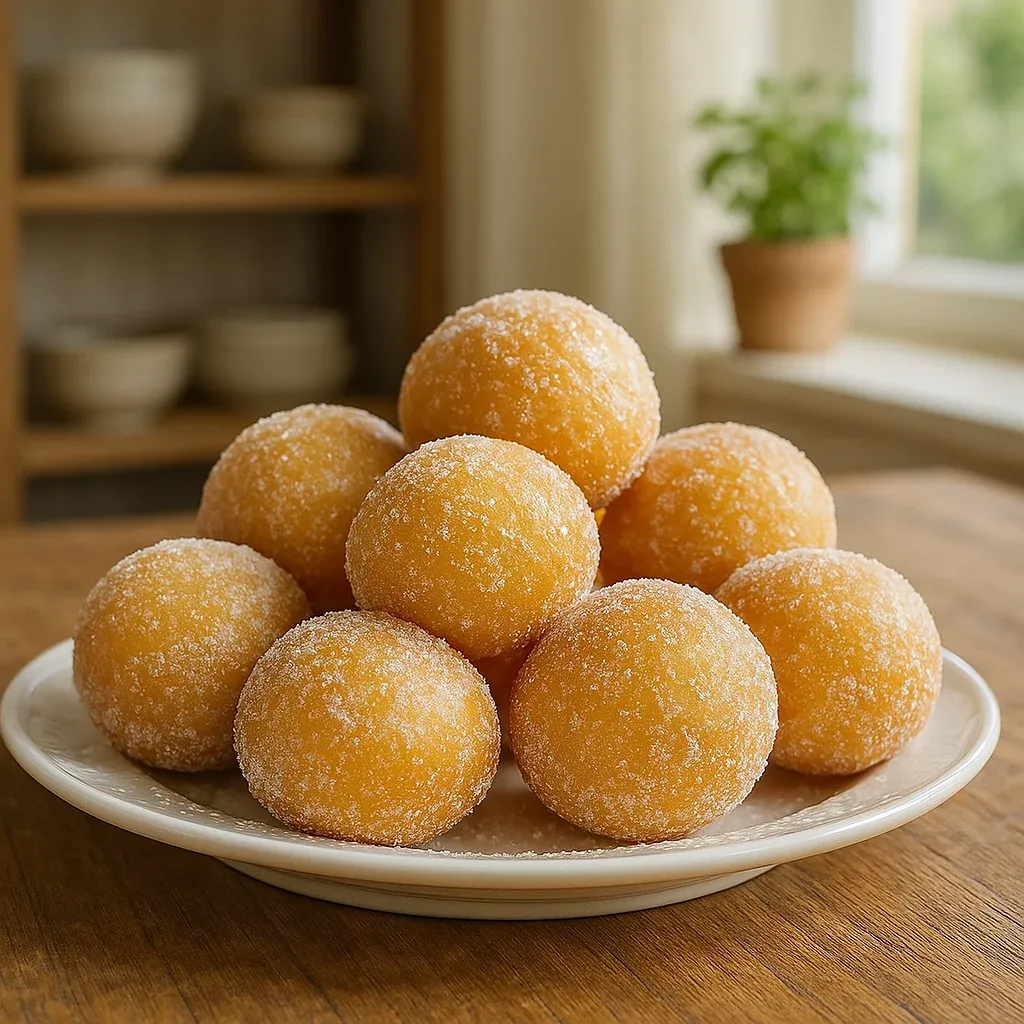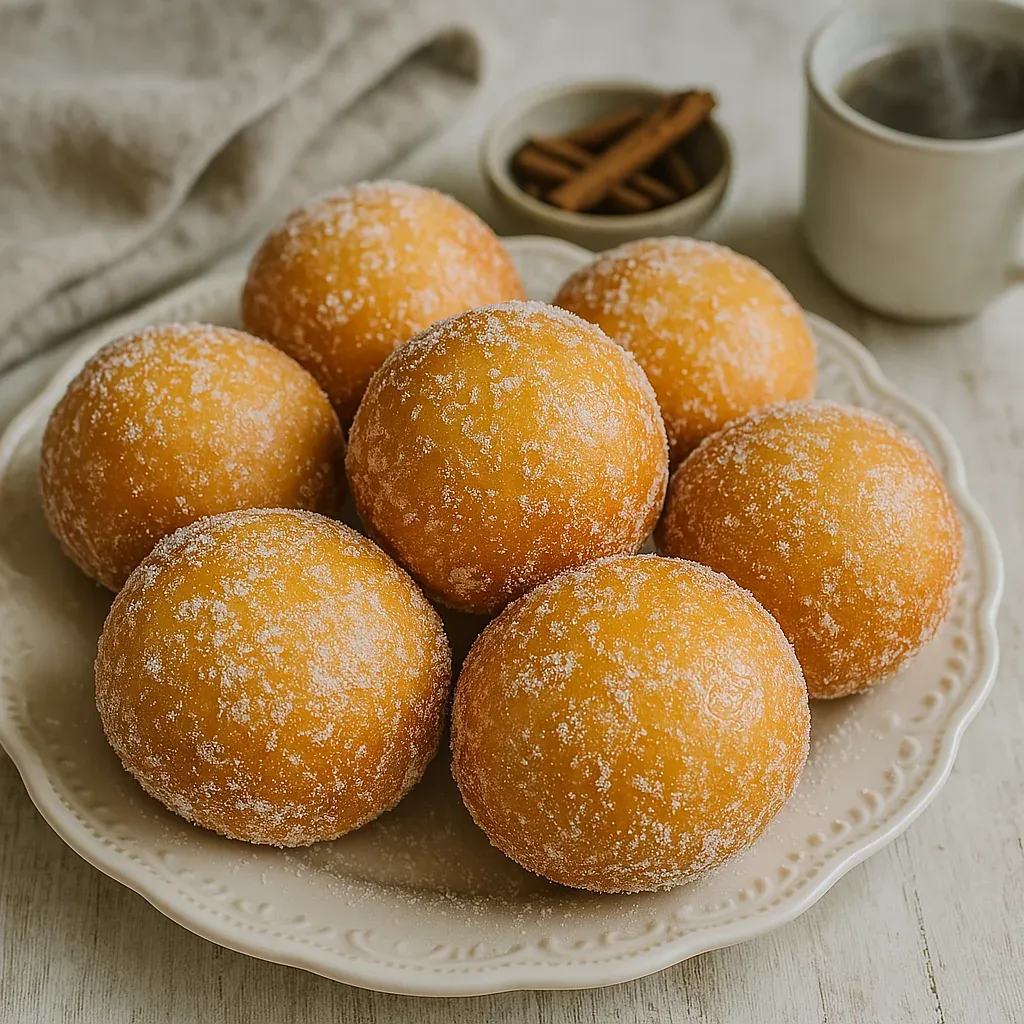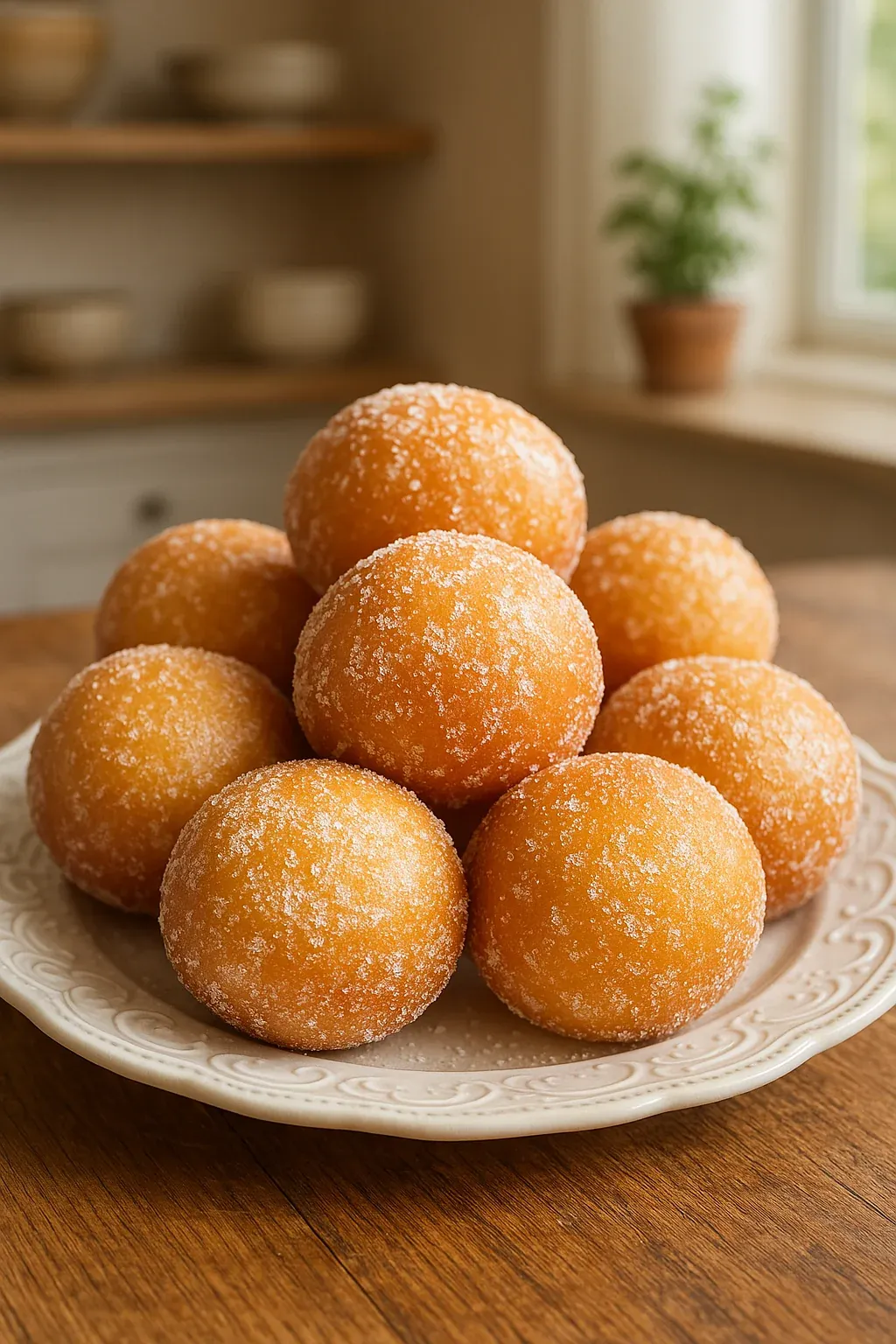 Pin it
Pin it
This sweet, pillowy Portuguese doughnut recipe has been in my family for generations, passed down from my grandmother who learned it during her travels to Hawaii where malasadas are immensely popular.
I first made these malasadas during a rainy weekend when my children were bored and restless. The kitchen filled with the irresistible aroma of fried dough, and within minutes of the first batch being rolled in sugar, everyone gathered around. Now they request these Portuguese doughnuts for every special occasion.
- All purpose flour: Provides the perfect structure for these light doughnuts. Use unbleached for best results.
- Granulated sugar: Adds just the right sweetness without overpowering. Look for fine granulated for the coating.
- Active dry yeast: Creates the airy texture that makes malasadas special. Ensure it's fresh for proper rising.
- Warm milk: Activates the yeast and adds richness. Whole milk works best, but 2 percent is fine too.
- Eggs: Bind the dough and contribute to the rich golden color. Room temperature eggs incorporate better.
- Unsalted butter: Enriches the dough with flavor. Use European style for extra richness.
- Vanilla extract: Enhances the overall flavor profile. Pure extract makes a noticeable difference.
- Salt: Balances the sweetness and enhances flavor. Sea salt or kosher salt work wonderfully.
- Vegetable oil for frying: Creates that perfect crisp exterior. Use a neutral oil with high smoke point.
- Activate The Yeast:
- Combine warm milk (around 110°F) with a teaspoon of sugar and your yeast in a small bowl. The sugar feeds the yeast while the warm milk wakes it up. Wait patiently for 5 to 10 minutes until the mixture becomes foamy and fragrant. If this doesn't happen, your yeast might be dead and you should start over with fresh yeast.
- Create The Dough:
- In a large mixing bowl, whisk together the flour, sugar, and salt until evenly distributed. Make a well in the center and add your eggs, melted butter, vanilla, and the activated yeast mixture. Mix everything together using a wooden spoon until you have a sticky, cohesive dough. The stickiness is normal and actually crucial for light, fluffy malasadas.
- First Rise:
- Cover your bowl with a clean kitchen towel or plastic wrap and place it in a warm, draft-free area of your kitchen. Let the dough rise undisturbed for 1 to 2 hours. During this time, the yeast works its magic, feeding on sugars and creating carbon dioxide bubbles that expand the dough. You'll know it's ready when it has roughly doubled in size and appears puffy and full of air.
- Shape The Doughnuts:
- Gently punch down the risen dough to release excess air bubbles. Turn it onto a lightly floured surface, taking care not to incorporate too much additional flour which could make the doughnuts tough. Divide the dough into equal portions about the size of golf balls, using a dough scraper or knife. Roll each portion into a smooth ball by cupping your hand over the dough and moving in circular motions. Place the formed balls on a floured baking sheet and let them rest for 15 minutes, allowing the gluten to relax.
- Fry To Perfection:
- Heat oil in a heavy-bottomed pot or deep fryer to exactly 350°F, checking with a thermometer for accuracy. The precise temperature is crucial: too hot and the outside will burn before the inside cooks; too cool and the doughnuts will absorb excess oil, becoming greasy. Working in small batches, carefully lower 2 to 3 dough balls into the hot oil using a slotted spoon. Fry for 2 to 3 minutes on each side until they reach a deep golden brown color, rolling them occasionally for even cooking.
- Sugar Coating:
- Remove the fried malasadas with a slotted spoon, allowing excess oil to drip back into the pot. Place them briefly on paper towels, then immediately roll in granulated sugar while still hot. The residual heat helps the sugar adhere to the surface, creating that classic sweet coating that makes malasadas irresistible.
 Pin it
Pin it
Vanilla is my secret weapon in this recipe. While not strictly traditional, it adds a warm aromatic quality that enhances the overall experience. My grandmother would sometimes add a splash of brandy instead, which creates an interesting depth of flavor if you're feeling adventurous.
Storage Tips
Malasadas truly shine when eaten fresh, but if you must store them, keep them in a paper bag at room temperature for up to 24 hours. Avoid airtight containers, which trap moisture and make the sugar coating dissolve. Never refrigerate these doughnuts as the cold air dramatically accelerates staling. If you need to preserve them longer, freeze the unsugared fried malasadas, then reheat in a 350°F oven for about 5 minutes and roll in fresh sugar while warm.
Cultural Significance
Malasadas trace their origins to the Portuguese island of Madeira and hold special significance during Carnival season just before Lent. Portuguese immigrants brought this tradition to Hawaii in the 19th century when they came to work on sugar plantations. Today, in Hawaii—particularly on Oahu—malasadas are beloved treats, with specialized bakeries dedicated to perfecting these golden pillows of fried dough. The tradition of making malasadas on Shrove Tuesday uses up sugar and fat before the fasting period of Lent begins.
 Pin it
Pin it
Perfect Pairings
These sweet treats pair wonderfully with strong coffee, especially a Portuguese-style espresso, which cuts through the richness. In Hawaii, many enjoy malasadas with tropical fruit juices like guava or passionfruit. For an elegant dessert presentation, serve warm malasadas alongside vanilla bean ice cream or a dollop of whipped cream and fresh berries. The contrast of temperatures and textures creates a memorable dessert experience.
Frequently Asked Questions
- → What makes malasadas different from regular doughnuts?
Malasadas are typically lighter and fluffier than traditional doughnuts, with a soft, airy interior and no central hole. They are also traditionally coated in granulated sugar.
- → Can I fill malasadas with custard or jam?
Yes, malasadas can be filled with custard, jam, Nutella, or any other filling of your choice for extra flavor.
- → What type of oil should I use for frying malasadas?
Use a neutral oil such as vegetable or canola oil for frying, as these oils have a high smoke point and do not interfere with the flavor of the dough.
- → How do I store malasadas?
Store malasadas in an airtight container at room temperature for up to 2 days. Avoid refrigeration, as it can make them dry out.
- → What’s the ideal temperature for frying malasadas?
Fry malasadas in oil heated to 350°F (175°C) for the best results. Use a thermometer to maintain an even temperature.
- → Can I customize the sugar coating for malasadas?
Yes, you can mix granulated sugar with cinnamon or use powdered sugar for a different twist on the coating.
